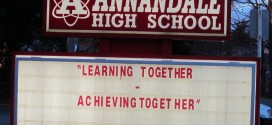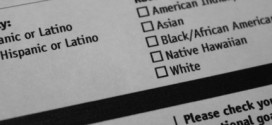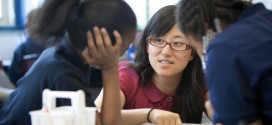By Tamara Treichel
Asian American students have the reputation of being high achievers, diligent, obedient, and, in short, any teacher’s dream – the “perfect students.” This has led to the “model minority” myth regarding Asian Americans. Yet one should regard all stereotypes with caution.
As Kim Wong Keltner humorously and yet also poignantly pointed out in her memoir Tiger Babies Strike Back, not all Asian American children consistently churn out A’s – there are also the middle-of-the-roaders, namely those who get B’s. And of course, there are Asian American students who perform poorly or who even have special needs, an umbrella term which encompasses a large range of disabilities, such as ADHD, Asperger’s Syndrome, Autism, Cerebral Palsy, Down’s Syndrome, etc.
For example, in Battle Hymn of the Tiger Mother, Amy Chua mentions her youngest sister Cindy, who has Down’s Syndrome. Yet references to persons with special needs are rare enough in America’s popular and literary culture, and they are especially rare where Asian Americans are concerned – after all, where are today’s Asian American counterparts to Charlie in Flowers for Algernon, Raymond in Rain Man, or Benjy in The Sound and the Fury?
In fact, one could argue that the “model minority” myth may be making it more difficult for Asian American youth with special needs to get the recognition and help they need as their problems are more often ignored.
It appears that “Asian American” and “special needs” are terms which are not frequently mentioned together, except perhaps when it comes to adopting children with special needs from Asian countries.
Asian Fortune contacted the Asian American Health Initiative at the Montgomery County Department of Health and Human Services (DHHS). A representative graciously replied that they haven’t had too many opportunities to serve children with special needs. What’s more, in the D.C. metro area itself, there appear to be no support groups catering especially to Asian American youth with special needs.
Yet fortunately, across the United States, awareness of and aid for this often overlooked group is growing. Some scholars have written about this topic, and some organizations and professionals are reaching out to facilitate the lives of Asian American youth with special needs and their caregivers.
As Jianhua Feng observed in the article “Asian American Children: What Teachers Should Know” (Feng, 1994), “the ‘whiz kids’ image is a misleading stereotype that masks individuality and conceals real problems. If Asian students are viewed as instant successes, there is less justification for assisting those who may need help. The result may be neglect, isolation, delinquency, and inadequate preparation for the labor market among those students.”
Feng also mentioned the disparity between the American educational system, which stresses individualism and independence, and Asian educational systems, which place more emphasis on the collective, self-effacement, and obedience to authority.
Moreover, Feng pointed out that a lack of English, financial resources, or parents who are busy struggling for survival, not proficient in English or unfamiliar with the American school system may also be factors that impede the academic success of Asian American youth.
Dr. Eun Mi Cho is a Korean American professor at California State University in Sacramento whose expertise is bilingual special education. She told Asian Fortune that her passion goes back to her days of being a special education teacher in California in early 1990, when she made two important observations.
She said that she had observed that first, many students “whose linguistic and cultural backgrounds are not from the typical mainstream white and middle-income households were misdiagnosed and misplaced. Through personal experiences and my research on assessment and evaluation processes, I learned quickly that there were not enough assessments for these children whose linguistic and cultural backgrounds are not from the typical mainstream white and middle-income households.”
Second, Cho said she had noticed that most professionals in special education are white, while most of their students come from different cultural and linguistic backgrounds.
“Since then, my research and teaching have been in bilingual special education, focused on the importance for teachers to implement culturally responsive teaching practices before referring Culturally and Linguistically Diverse (CLD) students for special education services so that we can ensure equitable opportunities for all students, regardless of their learning abilities,” she said.
Cho noted that the population from diverse cultural and linguistic backgrounds has been on the rise in the United States. Therefore, in special education, “providing appropriate education and assessment systems and practices is critical,” she believed.
She cited statistics from different sources which demonstrated the growing importance and increasing popularity of this field of research.
“Based on the U.S. Department of Education (USDOE) and the National Institute of Child Health and Human Development (NICHD), 20% of individuals above the age of five speak a language other than English at home in the U.S.,” she said.
Moreover, she said that the USDOE and NICHD (2003) estimated that nearly 40% of the school population will speak English as a second language by the year 2030 and that CLD youth under the age of 18 are expected to represent half of the population by 2023 (Mather, Pollard, & Jacobson, 2011).
Cho told Asian Fortune that in the United States, scholarly research has documented the overrepresentation of CLD students and disproportion in special education. For example, the likelihood of belonging to a certain CLD community may affect the likelihood of being placed in a specific disability category.
“Common examples are the higher population of African American boys in special education classes for students with emotional disturbance and behavior disorders and a much lower population of Asian American students in special education classes for students with learning disabilities,” she said, adding that she believed the disproportion mainly stems from referral processes and testing bias.
When asked what could be improved to facilitate the lives of Asian American children with special needs, Cho replied that the American public should be better educated about Asian cultures.
“Higher education teacher training programs need to recruit and train more teacher candidates with Asian cultural backgrounds while we include more courses […] to teach the importance of embracing diversity positively and to teach the specific teaching and assessment strategies to teachers, so that they meet the needs of Asian American children with special needs and their caregivers at sites,” Cho said. She also said that teachers should learn more facts about Asian cultures and get to know their students and the students’ parents better.
Moreover, Cho said that Asian parents of children with disabilities should not be afraid to reveal their children’s disabilities and study America’s mainstream school culture to become strong advocates of their own children. Cho also suggested that parent support groups may be beneficial, adding that she herself has been leading a parent support group, One Mind Group, since 1998 in California.
Friends of Children with Special Needs (FCSN) is a 501(c)(3) non-profit organization with headquarters in Fremont, California that serves over 800 Asian children and adults with special needs and their families. FCSN was founded in 1996 by 10 families, and was launched primarily as a volunteer-based organization, but has now grown to include over 100 paid staff.

FCSN’s Vice President of Local Programs Anna Wang took some time out from her busy schedule to talk to Asian Fortune. “Our mission is to help children with special needs and their families find love, hope, respect, and support through integrated community involvement,” she said.
“In the Asian culture, there is a shame and stigma associated with children with special needs. Many families isolate themselves from society, giving up hope for support and services for their children. FCSN continues to change the mindset of this population through our village of support. Volunteers and members’ families are the life-blood of the FCSN village,” Wang said. She added that FCSN offers three types of programs, namely Family Support, Children’s Programs, and Adult Programs.
Wang said that FCSN’s Family Support Programs include education seminars for parents, a support group, counseling, and family recreation activities such as camping, hiking, picnics, and potlucks. Meanwhile, the Children’s Programs include early therapy intervention, afterschool programs, summer camps, sports, music, arts, and life skills and social skills training. Lastly, FCSN’s Adult Programs include vocational training, job placement and coaching, an adult day program, supported living and independent living services.
When asked what she thought could be improved to facilitate the lives of Asian American children with special needs and their caregivers, she replied that they should be informed about their rights and the benefits they are entitled to. Furthermore, she said that companionship, a sense of security, and conveying the feeling that Asian American children with special needs and their families are not alone would be extremely helpful.
“FCSN’s vision is to deliver happiness to Asian American special needs children and their caregivers through friendship, support, and services. Since most of our Family Support and Children’s Programs are free or affordable and our Adult Services are completely subsidized by the Federal and State government, Asian American special needs children and their families have better access to FCSN’s culturally sensitive services and support,” Wang said.

Overall, she said she believed that the situation of Asian American children with special needs has improved since FCSN’s founding in 1996. Wang said that due to FCSN’s strong outreach efforts, many Asian American families have stepped forward and worked together to build a better future for their children.
“Since our conception, FCSN has built two centers in the Bay Area, one in Fremont and another one in San Jose. Furthermore, 26 Asian American families joined forces and resources to build housing for their special needs children to create a model community,” she said, adding that many special needs organizations in the Bay Area are trying to emulate the FCSN model.

As the Asian American population in the D.C. metro area and the United States overall continues to grow, hopefully awareness, support, and love for Asian American youth with special needs will continue to grow as well.
 Asian Fortune Your source for all things Asian American
Asian Fortune Your source for all things Asian American



